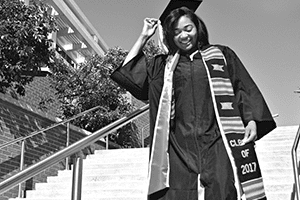A Teachable Moment in Deeply Troubled America
“Children have never been very good at listening to their elders, but they have never failed to imitate them.” — James Baldwin
In the weeks since the election, network news and social media feeds have continued to reveal the corrosive effect of toxic and damaging rhetoric on our children: Images of swastikas and “Whites Only” scribbled on school bathroom stalls; cell phone videos capturing children in a school cafeteria chanting “Build that wall,” with Latino peers appearing stunned and frightened; stories of girls being assaulted; reports of Muslim American students taunted and terrorized; and news of a young Trump supporter getting beaten by peers.
As horrifying as the pictures and videos are, we shouldn’t be surprised that some of our young people are trying on the language of hate, fear, and indifference. They are echoing and imitating the basest of all they are seeing and hearing from us.
American discourse as we taught them.
But it’s not just the vitriol of the past 19 months that young people are absorbing from us. Before candidates even took to the debate stage, our children were already feeling the pain, fear, and anger of an increasingly challenging, unequal, and starkly divided America. They watched parents losing jobs and fearing for the future, saw horrific images of racially charged police brutality, witnessed family members being deported, and choked down the 24-hour media feed of fear-fueled prejudice and violence based on religious, ethnic, and sexual identity.
And they are left questioning all the things we ever taught them about America.
That freedom, equality, and diversity were the most cherished riches of this nation of immigrants.
That the struggles of the past for justice and equality were now secured. That our victories were irreversible and progress inevitable.
And that America’s best days were always ahead.
But that is not the America in which our children are growing up. Or, if we’re honest, ever was.
What they are learning is that these United States are more divided than we ever acknowledged — or wanted our children to know. That there is still much more work to do to live up to our ideals. And that there are no heroes who alone will swoop in and save the day and in whose likeness we will chisel our next monuments — that there is, and ever has been, only us.
It is a teachable moment in a deeply troubled America. And whether we’re ready for it or not, our children are looking to us for answers — and to lead the way forward.
For cues, we might do well to look to the young people who are rising up against the wave of civic loathing, anxiety, and division and taking up the mantle of our better angels. They are covering lockers and hallways with messages of equality, diversity, and love. They are holding vigils. They are having hard conversations — across differing races, ethnicities, political leanings, and beliefs — in classrooms and after-school clubs. They are reaching out, writing letters to President-elect Trump about their lives, their hopes, and their fears. They are speaking up bravely, calling out injustice, and marching peaceably in places like D.C. and Maryland for the values they hold dear.
And they are watching to see what we’ll do.
This is a critical moment for advocates. We must sound our voices louder than ever before, listen harder than ever before, and advance the causes of justice and equality and interdependence with more resolve and vigilance than ever before.
John F. Kennedy said, “Children are the living messages we send to a time we will not see.”
Let us teach America’s young people that we cannot — and will not — quit on America’s ideals.
That our liberations are bound up in each other’s.
That we are mightier than the struggles ahead.
And that fighting for what’s right is, indeed, always worth it.
Photo credit: Joe Brusky








